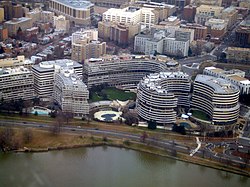The
Watergate Seven has two meanings: (1) it refers to the five men caught
June 17, 1972 ... P. Weicker, Jr.'s indicating that one of the men in Watergate bugging case had been ordered in the spring of 1972 ... Nixon revealed much later that he would not grant amnesty to the Watergate Seven because, if he did so, Nixon ...
Watergate Seven
From Wikipedia, the free encyclopedia
| Watergate scandal |
|---|

|
| Events |
| People |
The period leading up to the trial of the first Watergate Seven began on January 8, 1973.[3] The term "Watergate Seven" was coined a few months later, in April 1973, by American lawyer, politician, and political commentator Ed Koch, who, in response to U.S. Senator Lowell P. Weicker, Jr.'s indicating that one of the men in Watergate bugging case had been ordered in the spring of 1972 to keep certain Senators and Representatives under surveillance, posted a sign on the door of his United States Congress office saying, 'These premises were surveilled by the Watergate Seven. Watch yourself'.[4]
The seven advisors and aides later indicted in 1974 were:[5]
- John N. Mitchell – former United States Attorney General and director of Nixon's 1968 and 1972 election campaigns; faced a maximum of 30 years in prison and $42,000 in fines; on February 21, 1975, Mitchell was found guilty of conspiracy, obstruction of justice, and perjury and sentenced to two and a half to eight years in prison, which was later reduced to one to four years; Mitchell actually served 19 months.
- H. R. Haldeman – White House chief of staff, considered the second most powerful man in the government during Nixon's first term; faced a maximum of 25 years in prison and $16,000 in fines; in 1975, he was convicted of conspiracy and obstruction of justice and received an 18-month prison sentence.
- John Ehrlichman – former assistant to Nixon in charge of domestic affairs; faced a maximum of 25 years in prison and $40,000 in fines. Ehrlichman was convicted of conspiracy, obstruction of justice, perjury and other charges; he served 18 months in prison.
- Charles Colson – former White House counsel specializing in political affairs; plead nolo contendere on June 3, 1974 to one charge of obstruction of justice, having persuaded prosecution to change the charge from one of which he believed himself innocent to another of which he believed himself guilty, in order to testify freely.;[6] he was sentenced to 1 to 3 years of prison and fined $5,000; Colson served seven months.
- Gordon C. Strachan – White House aide to Haldeman; faced a maximum of 15 years in prison and $20,000 in fines. Charges against him were dropped before trial.
- Robert Mardian – aide to Mitchell and counsel to the Committee to Re-elect the President in 1972; faced 5 years in prison and $5,000 in fines. His conviction was overturned on appeal.[7]
- Kenneth Parkinson – counsel for the Committee to Re-elect the President; faced 10 years in prison and $10,000 in fines. He was acquitted at trial. Although Parkinson was a lawyer, G. Gordon Liddy was in fact counsel for the Committee to Re-elect the President.
References
- Haley, Ken (June 14, 2008). "True confessions: Frost and Nixon". The Canberra Times.
|section= ignored (help)
No comments:
Post a Comment